Traditional Vietnamese dishes use a variety of natural ingredients and are processed based on the principles of yin and yang—the five elements that have created thousands of delicate, nutritious dishes.
Traditional Vietnamese food is cherished for its vibrant flavors, fresh ingredients, and variety of noodle and rice dishes. From flavorful Pho noodle soup to crispy Spring rolls, Vietnam offers an array of mouthwatering foods for visitors to discover. This article explores some of the most popular and beloved Vietnamese dishes that highlight the diversity of Vietnam traditional cuisine.
- 1. Pho
- 2. Banh Mi
- 3. Com Tam (Broken rice)
- 4. Goi Cuon (Spring rolls)
- 5. Nem Ran/ Cha Gio (Fried spring rolls)
- 6. Bun Cha (Grilled pork with rice vermicelli)
- 7. Bun Dau (Fried tofu with rice vermicelli)
- 8. Xoi (Sticky rice)
- 9. Banh Chung (Sticky rice cake)
- 10. Banh Cuon (Steamed rice rolls)
- 11. Banh Xeo (Crispy pancake)
- 12. Che (Sweet porridge)
- 13. Chuoi Nep Nuong (Grilled banana wrapped in sticky rice)
- 14. Banh dau xanh (Mungbean cake)
- 15. Tao pho (Tofu pudding)
- 16. Banh Bo (Honeycomb cake)
- 17. Banh Ran (Vietnamese donut)
1. Pho
Pho is a steaming bowl of deliciousness that's considered Vietnam's national treasure. It is a warm and comforting soup with thin rice noodles bathed in a rich and flavorful beef broth.
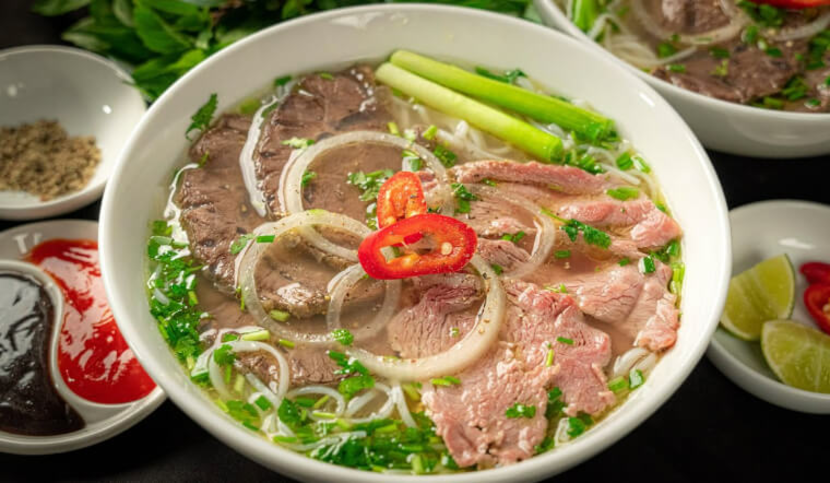
This broth is the star of the show! It's simmered for hours with beef bones and spices, creating a deep, savory flavor that warms you from the inside out. Thinly sliced beef is added to the broth, and depending on your preference, you can choose rare, well-done, or a combination.
Pho is popularly enjoyed as a traditional Vietnamese breakfast. However, people also have it for lunch and dinner thanks to its nutrition. Street vendors often have steaming pots ready in the early morning, while restaurants serve it throughout the day. Every bowl is typically accompanied by a plate of fresh herbs and bean sprouts. You add these to your soup for an extra layer of freshness and crunch, customizing each bite to your own taste.
- Where to eat: Pho Thin, 13 Lo Duc, Hai Ba Trung District, Hanoi
2. Banh Mi
Banh Mi is another national Vietnamese food. It includes crusty bread with delicious fillings rich in Vietnamese flavor.
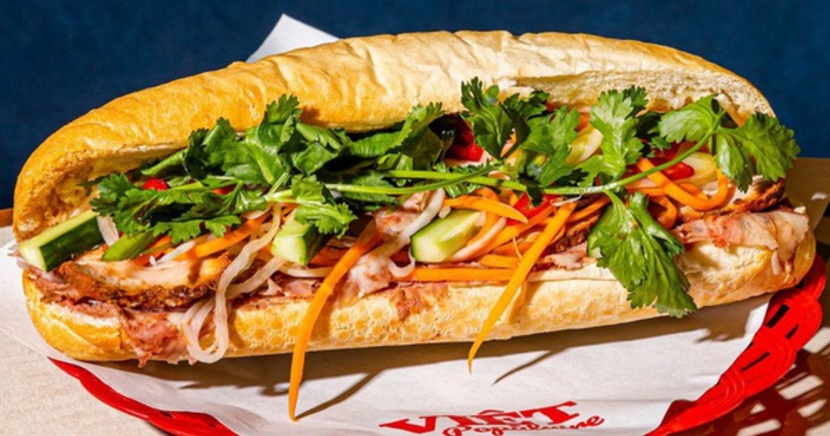
You can try Banh Mi in many ways, with more or less meat, spicy or nonspicy. Vendors pile in all sorts of tasty ingredients, from savory meats like grilled pork or lemongrass chicken to cool and crunchy vegetables like pickled carrots and cucumbers. You might even find pate, a creamy spread, or a fried egg peeking out. People also serve banh mi with fresh cilantro, some creamy mayonnaise, and a sprinkle of chili flakes.
This handheld delight is perfect for breakfast, lunch, or a tasty snack on the go. Vendors are a common sight in almost every corner of Vietnam. Each bite gives you a perfect burst of textures and flavors.
- Where to eat: Banh My Phuong, 2B Phan Chau Trinh, Hoi An
3. Com Tam (Broken rice)
Com tam is a flavorful and satisfying meal made with broken grains of rice.

These broken rice grains, leftover from the milling process, were traditionally seen as less valuable. But Vietnamese ingenuity turned them into something delicious! The rice is cooked to fluffy perfection and becomes the base for a colorful and tasty creation.
Com tam is typically served with a variety of grilled meats like flavorful pork chops or shredded pork skin. A sunny-side-up egg adds richness, while fresh vegetables like cucumber and pickled sides bring a delightful crunch.
There’s also a dipping sauce that adds a salty and savory kick. It’s often made with fish sauce, sugar, lime, garlic, and chilli.
- Where to eat: 260 Vo Van Tan, District 3, Ho Chi Minh City
4. Goi Cuon (Spring rolls)
In Vietnam, there are plenty of fresh and healthy options, and Goi cuon (fresh spring rolls) are a prime example.
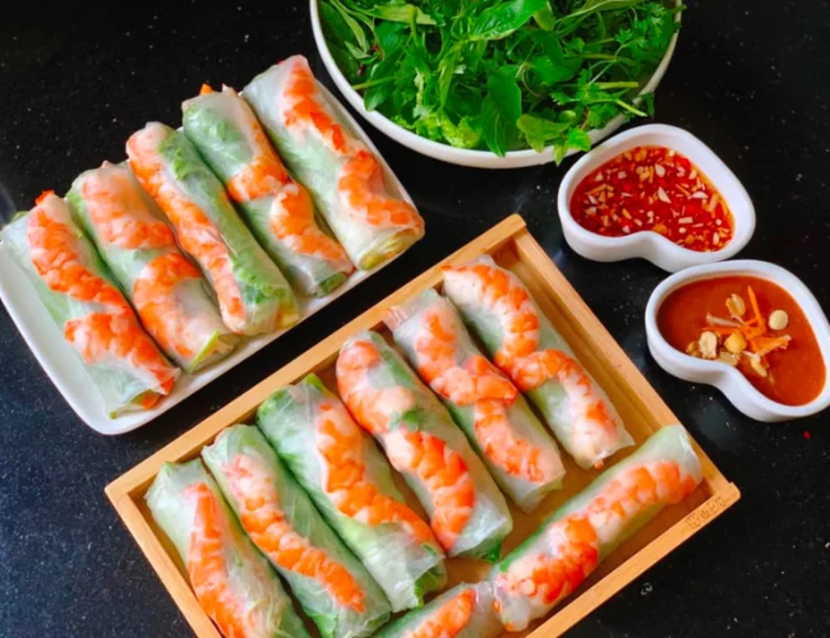
Goi cuon are colorful, fresh rolls wrapped in translucent rice paper. Inside, there's a mix of thin noodles, shrimp or pork slices, lettuce, bean sprouts, and mint & basil leaves for a nice smell. People often dip them in a flavorful peanut sauce for a layer of richness.
These bite-sized bundles can be enjoyed throughout the day. They're a popular appetizer at restaurants, a refreshing snack on a hot afternoon, or even a light lunch option.
- Where to eat: 420A Hoa Hao, Ward 5, District 10, Ho Chi Minh City
5. Nem Ran/ Cha Gio (Fried spring rolls)
Nem ran boasts a golden-brown, crispy exterior that encases a flavorful filling.
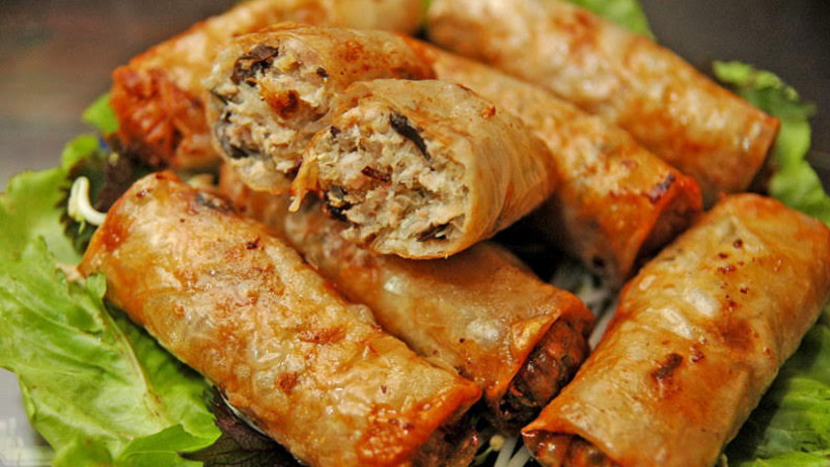
These yummy bites are usually made with a mix of ground pork and shrimp. Then people add shredded carrots, onions, wood-ear mushrooms, herbs, and glass noodles. Then, they are all wrapped up in thin rice paper sheets and deep-fried until crispy and golden.
Nem ran is often served with a dipping sauce of fish sauce, sugar, lime/vinegar, garlic, and chili. Vietnamese people love eating nem ran with raw vegetables such as lettuce, coriander, etc,...
- Where to eat: 123 Bui Thi Xuan, Hai Ba Trung, Hanoi
6. Bun Cha (Grilled pork with rice vermicelli)
Calling all noodle lovers! If you're looking for a dish that's both flavorful and refreshing, Bun Cha is a perfect option - a street food star straight from Hanoi, Vietnam.

Picture this: a bed of soft rice noodles topped with grilled pork patties and slices. The pork has this yummy smoky smell because it's marinated in lemongrass, fish sauce, and sugar, then grilled over charcoal until it's crispy outside and juicy inside.
People often eat bun cha with fresh herbs like mint and coriander and pickled veggies like carrots and papaya for a tangy kick. The dipping sauce is super important, too—it's a mix of fish sauce, vinegar, sugar, and water. If you like it spicy, you can add some chilies!
You can enjoy Bun Cha any time of day. Street vendors usually serve it up for lunch, but you can also find it in restaurants for a more chill vibe.
- Where to eat: 34 Hang Than, Ba Dinh, Hanoi
7. Bun Dau (Fried tofu with rice vermicelli)
This traditional dish is a favorite among locals and visitors alike, known for its bold taste and simple ingredients.
Bun Dau is a meal that combines different elements to create a tasty experience. It starts with bun, which are soft and easy-to-eat rice vermicelli noodles. These noodles are served alongside dau, which are blocks of fried tofu that soak up all the delicious flavors.
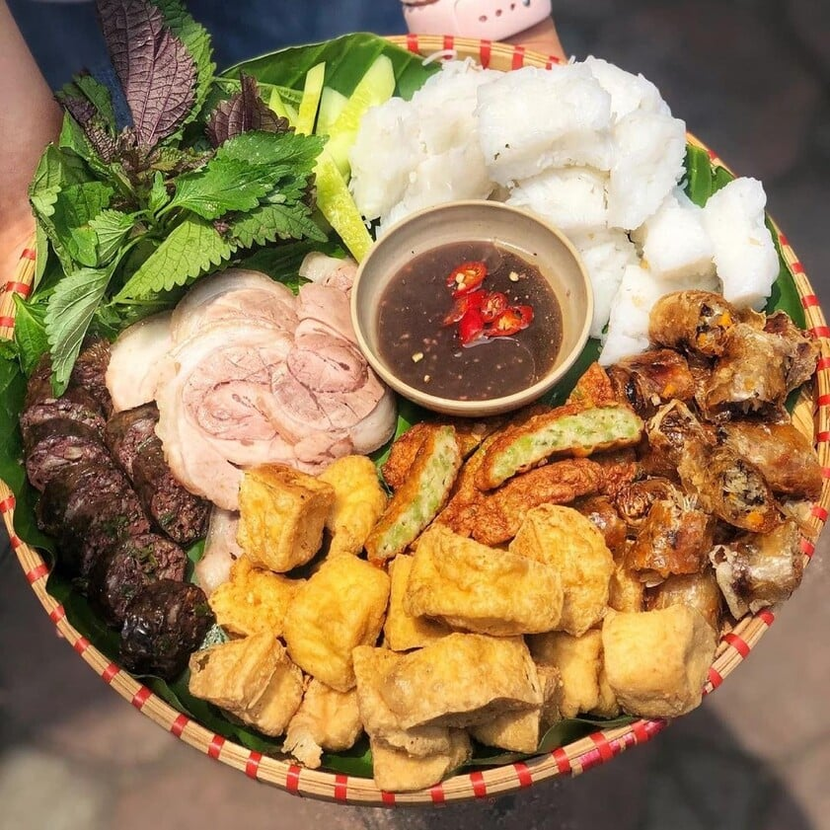
Now, here's where the magic happens: Mam Tom (Shrimp paste). This is a pungent shrimp paste sauce that packs a punch! It's made from fermented shrimp and has a strong smell, but don't let that scare you away. When paired with the noodles and tofu, it adds a savory richness that's hard to resist.
Besides noodles and tofu, people often add boiled pork belly, nem ran, and green sticky rice patties. You'll often find bun dau mam tom served as a lunch or dinner option, especially during the warmer months. If you are looking for a Vietnamese authentic food, try a portion of Bun Dau.
- Where to eat: 23 Phan Huy Ich, Nguyen Trung Truc, Ba Dinh, Hanoi
See more: Bun - Rice Vermicelli: A guide to Vietnam's iconic noodle dishes
8. Xoi (Sticky rice)
Unlike the fluffy white rice you might be used to, Xoi is made with a special type of rice that gets nice and sticky when cooked.
This sticky rice is steamed to perfection, creating a chewy and satisfying base for a variety of toppings. It can be enjoyed as a savory breakfast or a sweet snack, depending on what you add to it.
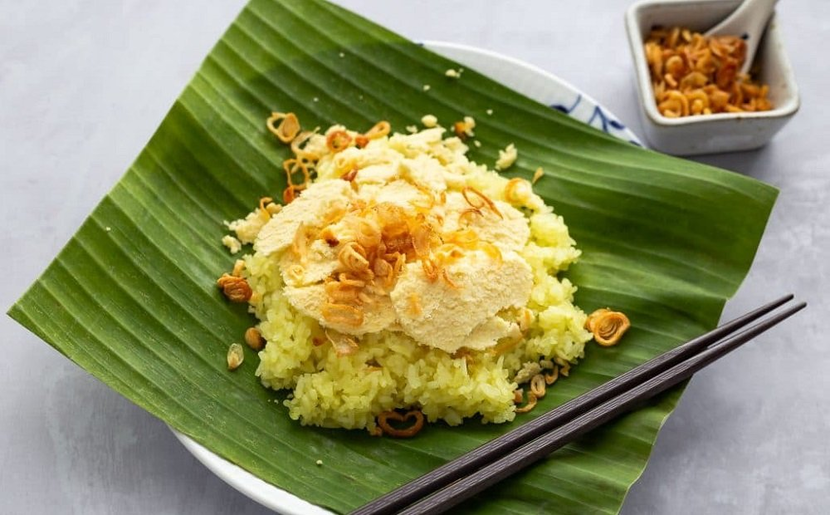
For a savory option, Xoi can be mixed with mung beans, mushrooms, or even shredded chicken. A sprinkle of crispy fried shallots and chopped peanuts adds an extra layer of flavor and texture. If you're craving something sweet, Xoi can be topped with fresh mango, corn, or even sweetened beans. A drizzle of coconut milk will make the dish more creamy.
Xoi is a popular street food that is easy to find and doesn’t cost much. Vendors often have steaming pots ready in the early morning, perfect for a grab-and-go breakfast. But Xoi is also enjoyed throughout the day, and some restaurants even offer it as a dessert option.
- Where to eat: 35B Nguyen Huu Huan, Hang Bac, Hanoi
9. Banh Chung (Sticky rice cake)
Banh chung is a special dish in the Vietnamese tradition that is often made on Tet holiday.
Banh chung is a perfect combination of sticky rice, mung beans, and pork belly, all wrapped in dong leaves. These little packages are then bundled together and boiled for long hours, creating a firm and flavorful dish.
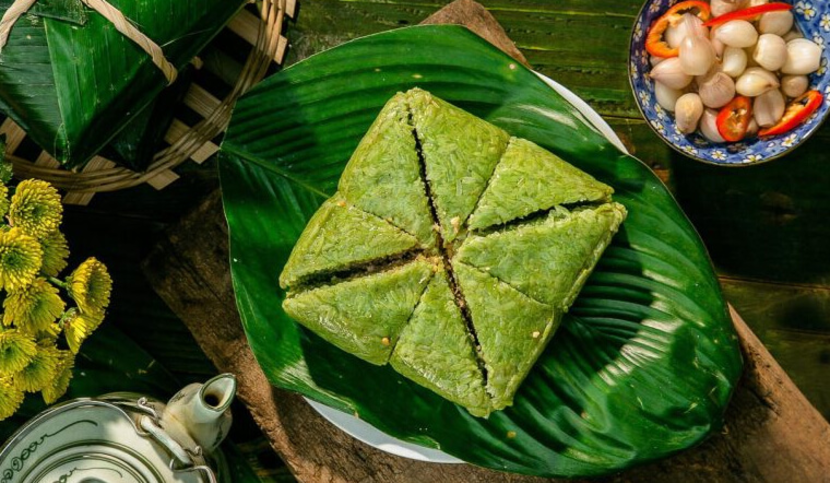
This dish is traditionally enjoyed during Tet celebrations. Families gather together, making and enjoying Banh Chung to wish for good luck and prosperity for the year ahead. However, when visiting Vietnam, you can always find it at markets or street vendors year-round.
- Where to eat: 43 Trai Gang Lane, Thanh Nhan, Hai Ba Trung, Hanoi
10. Banh Cuon (Steamed rice rolls)
Another traditional Vietnamese food that will surprise your taste is banh cuon (steamed rice rolls). These rolls, made from a batter of rice flour and water, are steamed to perfection, resulting in a soft and slightly translucent texture.
What makes banh cuon truly delicious is its filling. Typically, it consists of a flavorful mixture of seasoned ground pork, minced wood ear mushrooms, and sometimes shallots or onions. However, variations may include shrimp, chicken, or other ingredients based on regional preferences.
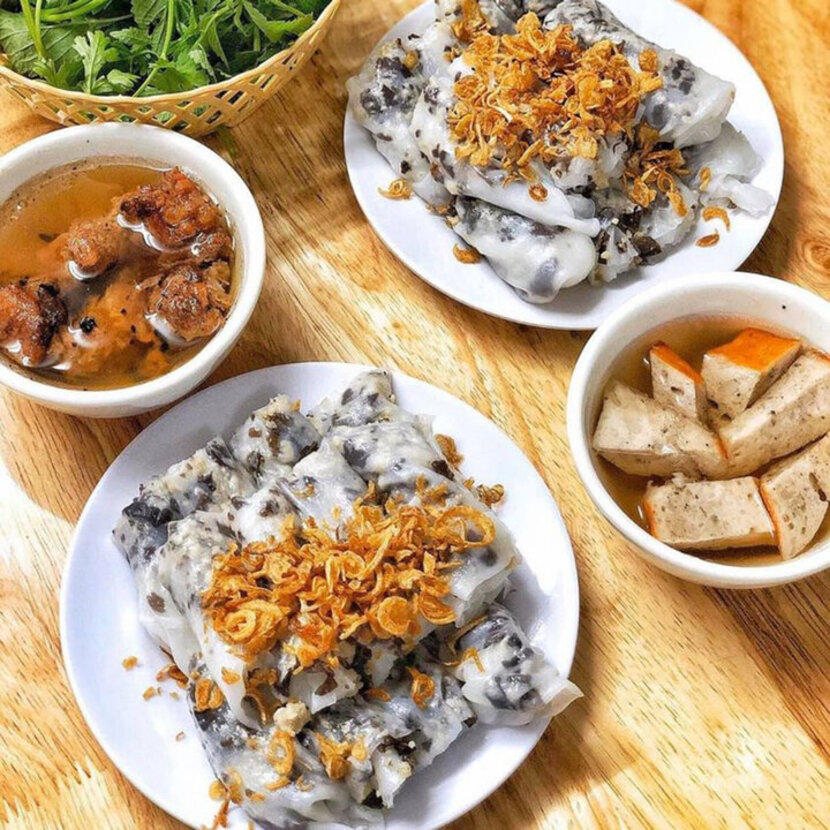
Banh cuon is often enjoyed as a light and healthy meal option, suitable for any time of the day. Whether served for breakfast, lunch, or dinner, it is commonly accompanied by fresh herbs like cilantro and mint, along with crispy fried shallots. There’s also a side of nuoc cham, a tangy dipping sauce made from fish sauce, lime juice, sugar, and chili.
- Where to eat: 68 Hang Cot, Hang Ma, Hoan Kiem, Hanoi
11. Banh Xeo (Crispy pancake)
Banh Xeo ( is a traditional Vietnamese savory crepe originating in Southern Vietnam. It consists of a large, thin crepe made from a rice flour batter flavored with turmeric. This crepe is cooked in a special pan until crispy on the outside and slightly chewy in the center.
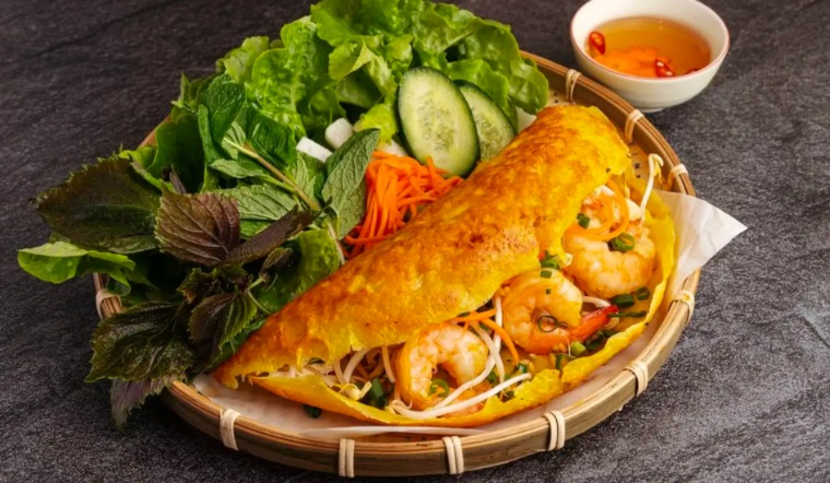
A savory filling often consist of shrimp, minced pork, and bean sprouts. Variations may include other seafood or diced vegetables. Banh xeo is folded over the filling to create a half-moon shape and served hot.
Banh xeo is eaten with a sweet and sour dipping fish sauce an fresh herbs like lettuce, mint, and basil. People often use rice papers to roll up fresh herbs and banh xeo into an open-ended cigar with firm pressure.
- Where to eat: Banh Xeo 46A, 46A D Dinh Cong Trang, District 3, Ho Chi Minh City
12. Che (Sweet porridge)
Che is a yummy Vietnamese dessert that comes in many tasty varieties. It's like a sweet soup or pudding with different ingredients like beans, fruit, or jelly. Some che are creamy and coconutty, while others are fruity and refreshing.
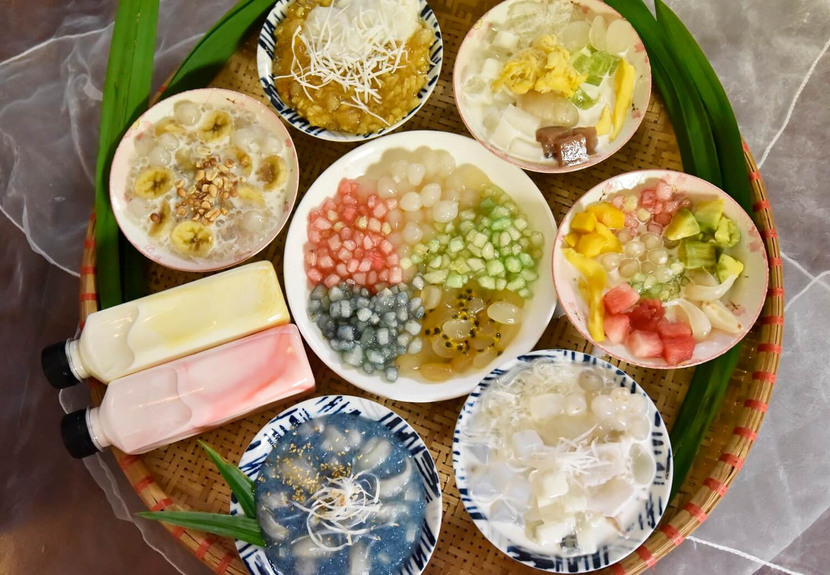
You can eat che hot or cold, depending on your preference. It's a popular snack or dessert enjoyed by both locals and visitors.
- Where to eat: 032, Block H, Su Van Hanh Street, District 10, Ho Chi Minh City
13. Chuoi Nep Nuong (Grilled banana wrapped in sticky rice)
Vietnam has this awesome street snack called Chuoi Nep Nuong. It's like a sweet and salty party in your mouth.
This yumminess originates from Ben Tre down south, but it's making waves all over Vietnam. The star of the show is the banana – super sweet and creamy.
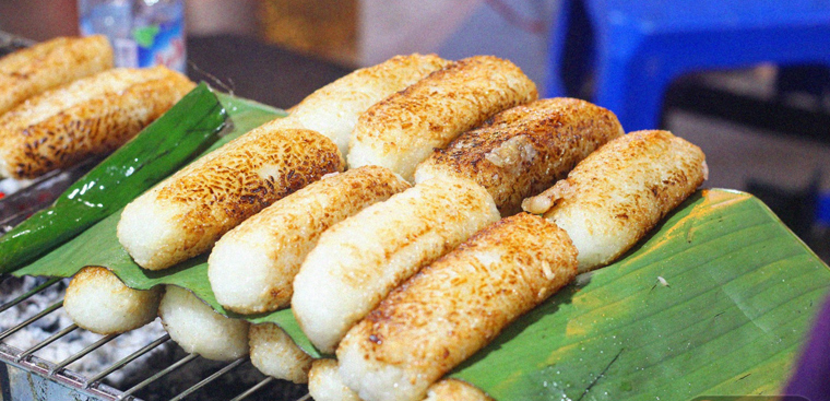
First, they wrap the bananas snugly in sticky rice. If you want something sweet, they soak the rice in coconut milk or jazz it up with scallions or dried coconut if you’re feeling savory. Next, they wrap it all up in banana leaves and throw it on the grill over hot coals. That's when you get that amazing smoky smell and that perfect golden color.
You can have it plain, savoring every flavor. Or, if you're feeling fancy, dip it in sweet coconut milk sauce. And don't forget the crunch – sprinkle some crushed peanuts or sesame seeds on top.
This treat received serious attention in 2023 when CNN listed it as one of the world's top nine desserts!
- Where to eat: Alley 378 Vo Van Tan, Ward 5, District 3, Ho Chi Minh City
14. Banh dau xanh (Mungbean cake)
Banh Dau Xanh is a popular traditional Vietnamese dessert that originates from Hai Duong province.
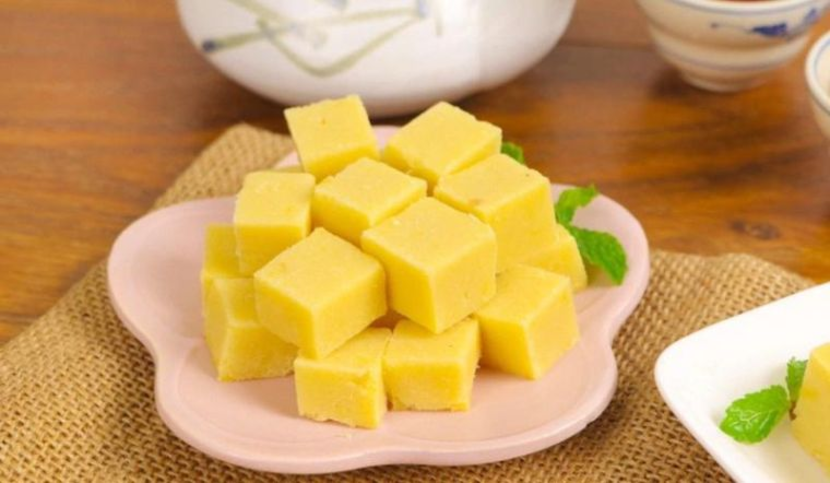
This special cake is made from a blend of mung beans, sugar, pomelo flower oil, and pork fat. Once cooked, the cake transforms into a dry, smooth powder that's carefully molded into rectangular shapes. The cake is aromatic and buttery-fudge-like. When you take a bite, it melts in your mouth right away.
You can simply pop a piece into your mouth and enjoy the sweet burst, or pair it with a cup of Vietnamese green tea to balance its sweetness.
- Where to eat: 27 Hang Giay, Hang Ma, Hoan Kiem, Hanoi
15. Tao pho (Tofu pudding)
Tao Pho is a refreshingly sweet and fragrant tofu-like dish that is a staple summertime treat across Vietnam. The exact origins of its name are uncertain, but some believe it comes from the word "tofu" as the two dishes share similarities in ingredients and preparation.
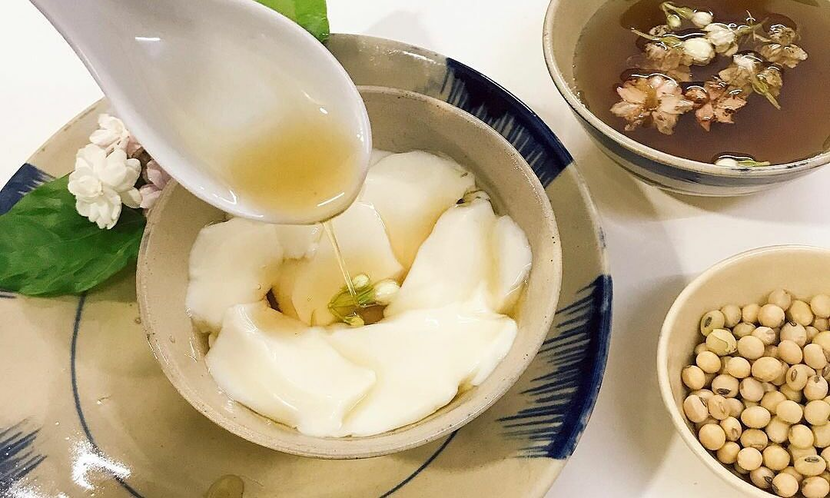
To make Tao Pho, soybeans are carefully ground and filtered to produce soy milk, which is then boiled, cooled, and set into solid curds. The resulting protein-rich curds have a soft, jelly-like texture.
While beloved nationwide, Tao Pho has subtle regional variations in Vietnam. In Hanoi, it is often served in sugar water flavored with aromatic jasmine flowers. In central Vietnam, it is topped with spicy minced ginger. And in southern Vietnam, coconut milk is commonly added for a richer taste.
Beyond the classic style, several modern versions of Tao Pho have also appeared. Some examples are Tao Pho with tapioca pearls and black sugar, caramel Tao Pho, and Tao Pho with jelly and lotus seeds. However, the traditional recipe served over ice remains a go-to way to beat the summer heat for Vietnamese people and tourists alike.
- Where to eat: 132 Doc Ngu, Ba Dinh, Hanoi
16. Banh Bo (Honeycomb cake)
Banh Bo is a delicious and unique dessert from southern Vietnam. Don't let the name fool you - it means "cow cake" or "crawl cake" because of its bumpy, bubbly appearance.
Made with rice flour, water, sugar, yeast, and coconut milk, Banh Bo has a soft and springy texture. The coconut milk adds a touch of sweetness and a tropical twist.
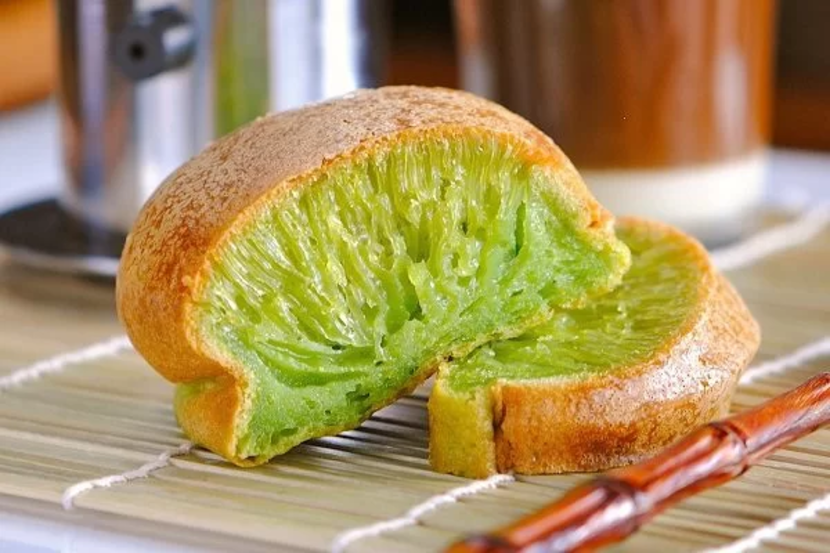
The secret to Banh Bo's unique texture lies in the batter. It ferments for a while, creating tiny air pockets that puff up when baked. This gives the cake its signature honeycomb look and light, spongy feel.
Banh Bo is a versatile treat. You can enjoy it on its own as a sweet snack, or have it with a meal as a palate cleanser. It's a popular choice at Vietnamese bakeries and markets, where they often slice up a whole cake for easy grab-and-go purchases.
- Where to eat: 32 Co Bac Street, Cau Ong Lanh Ward, District 1, City. Ho Chi Minh
17. Banh Ran (Vietnamese donut)
Banh Ran is a beloved street food and snack originating from northern Vietnam. The name "Banh Ran" translates to "fried cake" reflecting how these chewy, fried rice balls are prepared.
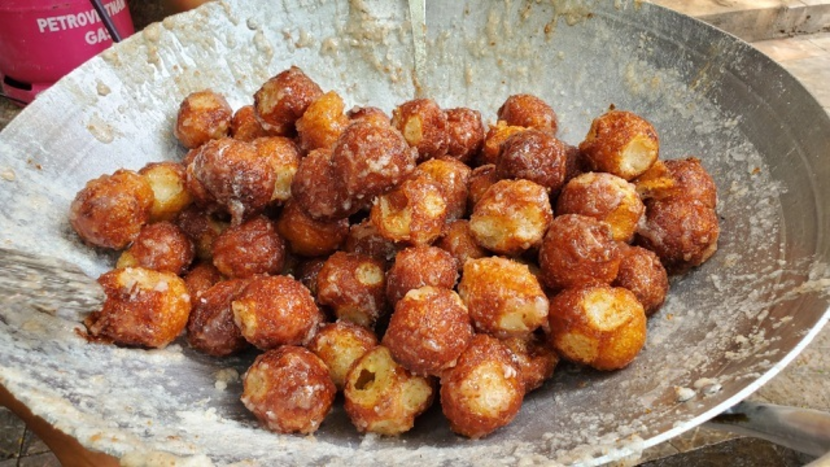
The outer shell of Banh Ran is made from a dough of glutinous rice flour and sometimes coated in white sesame seeds. The filling consists of a sweetened mung bean paste flavored with aromatic jasmine flower essence. Traditionally, the filling is separated so it rattles around inside the crispy shell.
Savory versions of Banh Ran also exist, filled with a blend of minced pork, wood ear mushrooms, vermicelli noodles, carrot, and seasonings. The savory Banh Ran is served with a sweet and sour chili dipping sauce.
- Where to eat: 52 Hang Chieu, Hang Buom, Hoan Kiem, Hanoi
Vietnam is a food lover's paradise, filled with delicious traditional dishes that will leave you craving more. If you're up for an adventure, why not explore Vietnam's food scene? Whether you're wandering the streets of Hanoi or sampling snacks at bustling markets, there's always something new and exciting to try.
Vietnam Culinary Tours w/ Best Price
See more:








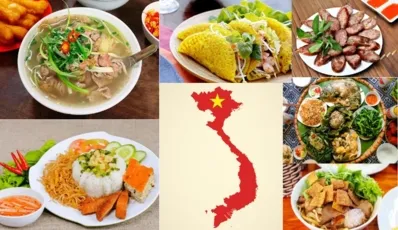
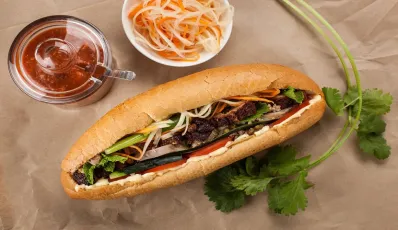

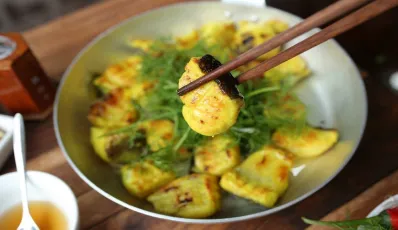

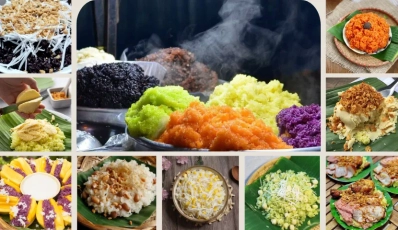
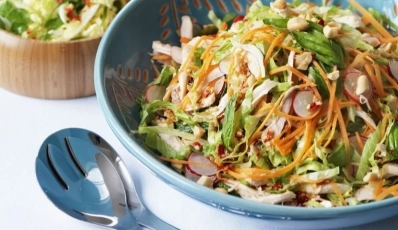





 TRAVELERS' CHOICE 2025
TRAVELERS' CHOICE 2025 



01 Comment
Jamaica
They will definitely tasty!!! This November I'm visiting visit Vietnam, I will try everything you recommend.
Write Reply